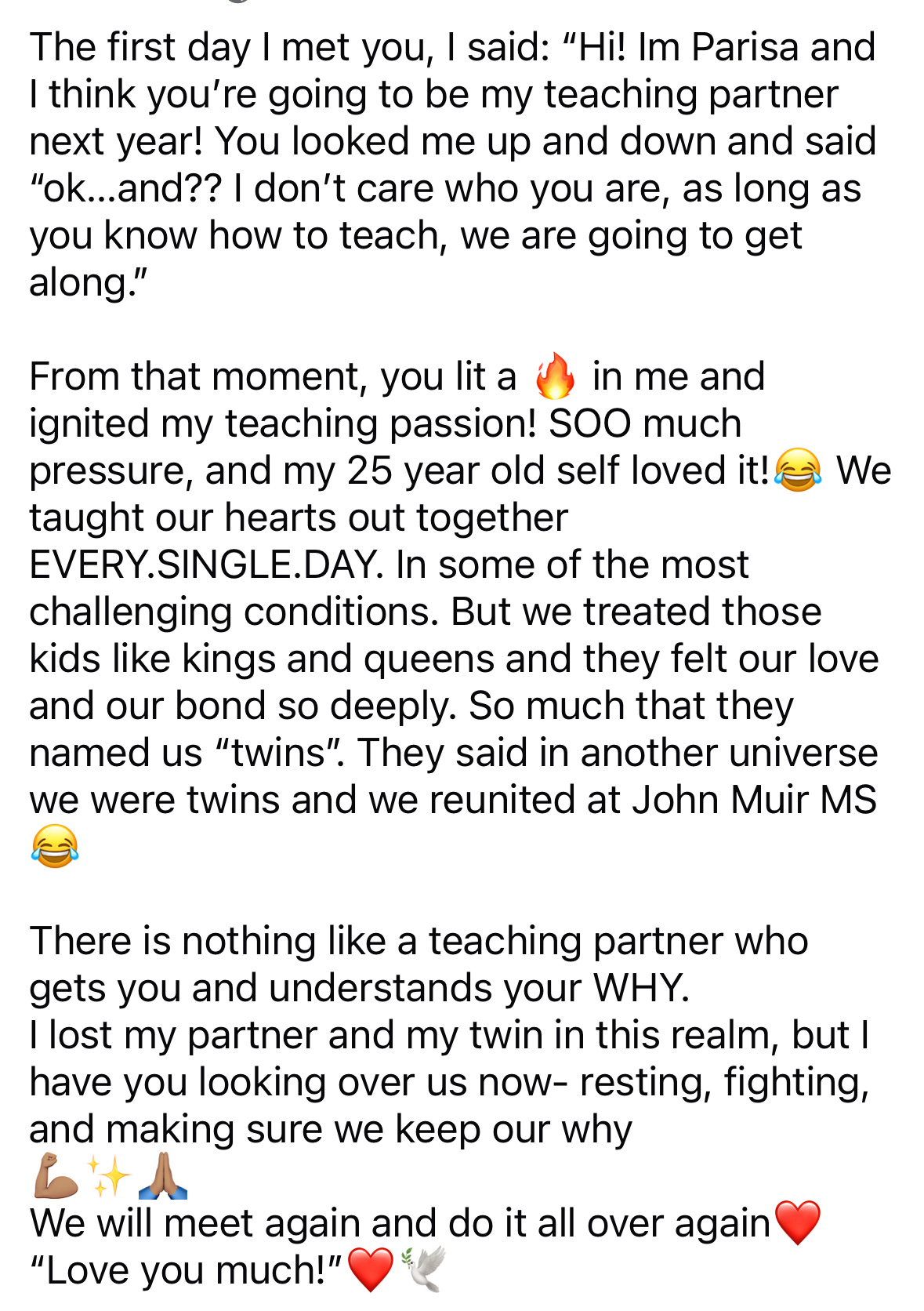Partnering in Teaching
A sacred and transcendent practice of solidarity. And a homage to a fine educator.
The teacher is regularly viewed (and quite often, correctly so) as a singular influence over their classroom. One with an important concentration of influence and power. This power is written about and researched to conclude “the teacher” as one of the most impactful factors (actors) that determines outcomes for students. 1 But what about teaching partners? What is the impact that a pair or a small group of teachers can have, not only on their students, but also on each other?
Anyone who has ever taught, has at some point experienced both profound loneliness and deep camaraderie. Teaching and learning are both social and cultural processes. They require collaboration. Put another way, teaching and learning is human. For teachers, who often feel like machines with the various demands put on them by a host of systemic and internal pressures, the sometimes dehumanizing experience of schooling in our institutions is circumvented through relationships. And one of the most powerful relationships is the kind forged “in the trenches” with a partner teacher.
This partner can often be a neighboring teacher who shares an adjacent classroom in a shared hallway or bungalow. Or a colleague who teaches in the same department. And when it is someone who teaches the same students despite teaching different subject matters, magic can happen. I have had many teaching partners in my career. And I have been blessed to have cultivated many lasting relationships, a beneficiary of a sacred magic that continues to enrich my life long after our partner teaching days ended. I am grateful for all of these relationships. But today I want to show appreciation for one teaching partnership I got to observe from afar, that of my wife and her first teaching partner, whom has passed on into the next realm.
Bridgette Dutton was my colleague in the history department before she became Parisa’s partner teacher (that is merely to establish a timeline, as we history educators like to do ;) We shared many conversations, observations, and at times disagreements (though those were few and far between.) What we shared most though was a commitment to a culturally relevant and community responsive pedagogy. Put another way, we shared a love for the kids at John Muir Middle School in South Central LA.
Bridgette was a Black educator in the powerful and far reaching tradition of Black educators2 who understood the difference between power of education as sacred practice and the system of schooling that non white students have and continue to be subjected to across generations. Education, and by extension teaching, was a practice of liberation. And therefore necessitated a struggle. Bridgette was oriented towards this fight. Her strength was clarity of voice and action. She would always “tell it like it is.”
At the same time she was courageously vulnerable, knowing that liberation from dehumanizing history and legacy required a deep sharing of one’s own humanity with others. I will never forget the day she shared with our history department a family artifact, a ledger documenting the enslavement of members of her ancestral lineage, and tried to help her colleagues grasp the deeper meaning and responsibility of teaching about slavery in classrooms full of Black students. She spoke passionately and openly about the personal and human impact that we needed to continually be aware of if we were to ever disrupt the continual harm this history, taught in traditional ways, could cause our students… and our colleagues.
When Parisa first started teaching with us at John Muir, I was impressed with how quickly she was able to establish herself and her practice, which was grounded in her ability to form relationships with her students. For those of you who know her, you know that the relational is one of her superpowers. But I never fully put it all together until this week, when we heard the news of Bridgette’s passing, and I realized just how important the partner teacher relationship was at that moment. The development of a collective pedagogy, divorced from a false sense of individualism and rooted in the deepest sense of collaborative process, to be human with another. To share an experience fully with someone else and come out the other side even more fully yourself than when you entered. This is the magic of a partner teacher relationship. Even now I am struggling to find words to describe it, but it is real. And so I will end with a poem and a screenshot. My poem is for Bridgette, my way to honor and thank her for what she gifted both Parisa and I in our journeys. The screenshot is Parisa’s own words that better describe what I was only fortunate enough to witness and learn from afar. May all of us find our teaching partners, our twins.
thankful that our topographies traversed together on this land that we were never meant to be here and now trapped in this time, in this way tonight the rain sounds like tears tomorrow children stand ready to face fears and unknowns armed with strength and a loving spirit hearts steadied by your teachings
John Hattie’s research most commonly referenced when speaking on this claim
As I reflect on my time with Bridgette, I think of Jarvis R. Givens’s Fugitive Pedagogy and how her practice was one with this lineage






A beautiful tribute.
💗